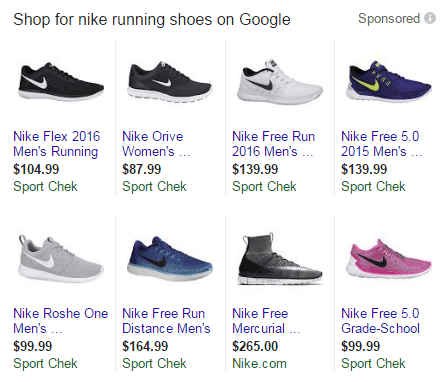
Navigate an unpredictable landscape with actionable, data-driven strategies tailored for your business from the brand down to the local level.

As consumers become more tech-savvy the marketing industry has had to update their practices. One innovation was the introduction of Google Shopping Ads and their Merchant Center – a variation of traditional paid search ads found in SERP’s. But caution should be taken before diving in head first. This resource is not intended for every business. In the following article, we will address what shopping ads are, who should be using them and the pros and cons of deploying this type of strategy.
Google Shopping Ads use the Google Merchant Center to pull product information and details that are related to a search query. Google will return a sponsored listing that combines this information with an image of the item. The listing will often be positioned at the top of the page or in the sidebar.
Types of information that can be displayed in Shopping Ads include:
In the example below, Sport Chek has decided to bid on keywords in my search (Nike running shoes) and returned the following sponsored ad at the side of the results page:

Google has some policies in place to ensure that the user experience is as effective as possible. First, in order to play, you have to pay. You will need to have a marketing budget and strategy devoted to SEM and you will need to be in a country where Shopping Ads are available. Second, you need a product. The service is best optimised for tangible goods that are safe and reputable such as records, TV’s and apparel. Items like firearms and fireworks are not permitted. Thirdly you require, and must actively manage, the information in Google Merchant Center. Depending on the level of granularity and your target audience you need to ensure that items are categorised correctly and that inventories and pricing are up to date. Finally, the organisation needs to ensure that it fits in with its paid media strategies – the infrastructure needs to be in place to support a conversion driven by the Shopping Ad. For example, if the website listed in the ad doesn’t lead to the product page or is out of stock it will limit the effectiveness of the platform.
Like most things Shopping Ads come with pros and cons.
Pros:
Cons:
Subscribe to our monthly newsletter.
I have spent a significant amount of time identifying reasons why Shopping Ads are great for retailers. But what if there was an opportunity for other industries to participate such as manufacturers and distributors?
Retailers and manufacturers share the same end goal – increase sales through quick turnover. In a retail environment, this happens at the register. For a manufacturer, it is traditionally thought that the sale ends once the product is purchased by the retailer or distributor. They already have their money so that is good enough right? Maybe. But if there is a mechanism in place that will increase conversions will this not require the retailer to replenish stock at a higher rate ultimately increasing the manufacturer’s revenue?
Manufacturers could consider subsidising the cost to run and manage Google Shopping Ads for select retail partners. Aside from the potential increase in sales, it could enable retailers that do not have the budget themselves to ‘play in the sandbox’ and establishing loyalty between the retailer and brand. Additionally, it could be used as a bargaining chip during negotiations to obtain better arrangements within their dealer network.
Google Shopping Ads are a proven paid search product that is ideal for certain verticals. They are constructed in a stimulating way and occupy premium space in a competitive landscape. But they also require dedicated resources in order to manage the data that is required to (successfully) run them. If you fall within the ‘sweet spot’ of the market they are ideal for and are looking for ways to boost the performance of your paid search campaigns Shopping Ads could be the natural next step in your digital marketing efforts.
Did this article resonate strongly with you? Contact DAC today!
Navigate an unpredictable landscape with actionable, data-driven strategies tailored for your business from the brand down to the local level.
Navigate an unpredictable landscape with actionable, data-driven strategies tailored for your business from the brand down to the local level.
Navigate an unpredictable landscape with actionable, data-driven strategies tailored for your business from the brand down to the local level.
Subscribe to our monthly newsletter.